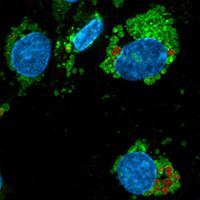Autofluorescence in freshly isolated adult human liver sinusoidal cells

Submitted: 5 October 2021
Accepted: 1 December 2021
Published: 13 December 2021
Accepted: 1 December 2021
Abstract Views: 1290
PDF: 664
HTML: 50
HTML: 50
Publisher's note
All claims expressed in this article are solely those of the authors and do not necessarily represent those of their affiliated organizations, or those of the publisher, the editors and the reviewers. Any product that may be evaluated in this article or claim that may be made by its manufacturer is not guaranteed or endorsed by the publisher.
All claims expressed in this article are solely those of the authors and do not necessarily represent those of their affiliated organizations, or those of the publisher, the editors and the reviewers. Any product that may be evaluated in this article or claim that may be made by its manufacturer is not guaranteed or endorsed by the publisher.
Similar Articles
- J. Melrose, The knee joint loose body as a source of viable autologous human chondrocytes , European Journal of Histochemistry: Vol. 60 No. 2 (2016)
- Y. Dong, C. Yang, Z. Wang, Z. Qin, J. Cao, Y. Chen, The injury of serotonin on intestinal epithelium cell renewal of weaned diarrhoea mice , European Journal of Histochemistry: Vol. 60 No. 4 (2016)
- Sabrina Giacoppo, Agnese Gugliandolo, Oriana Trubiani, Federica Pollastro, Gianpaolo Grassi, Placido Bramanti, Emanuela Mazzon, Cannabinoid CB2 receptors are involved in the protection of RAW264.7 macrophages against the oxidative stress: an in vitro study , European Journal of Histochemistry: Vol. 61 No. 1 (2017)
- Xiong Bing Li, Jia Li Li, Chao Wang, Yong Zhang, Jing Li, Identification of mechanism of the oncogenic role of FGFR1 in papillary thyroid carcinoma , European Journal of Histochemistry: Vol. 68 No. 3 (2024)
- I. Kopera, M. Durlej, A. Hejmej, K. Knapczyk-Stwora, M. Duda, M. Slomczynska, M. Koziorowski, B. Bilinska, Effects of pre- and postnatal exposure to flutamide on connexin 43 expression in testes and ovaries of prepubertal pigs , European Journal of Histochemistry: Vol. 54 No. 2 (2010)
- Y. Zhang, W.Y. Ye, J.Q. Wang, S.J. Wang, P. Ji, G.Y. Zhou, G.P. Zhao, H.L. Ge, Y. Wang, dCTP pyrophosphohydrase exhibits nucleic accumulation in multiple carcinomas , European Journal of Histochemistry: Vol. 57 No. 3 (2013)
- Shiyuan Chen, Longfei Zhang, Benchi Feng, Wei Wang, Delang Liu, Xinyu Zhao, Chaowen Yu, Xiaogao Wang, Yong Gao, MiR-550a-3p restores damaged vascular smooth muscle cells by inhibiting thrombomodulin in an in vitro atherosclerosis model , European Journal of Histochemistry: Vol. 66 No. 3 (2022)
- Christian Zuppinger, George Gibbons, Priyanka Dutta-Passecker, Adrian Segiser, Henriette Most, Thomas M. Suter, Characterization of cytoskeleton features and maturation status of cultured human iPSC-derived cardiomyocytes , European Journal of Histochemistry: Vol. 61 No. 2 (2017)
- W. Theunissen, D. Fanni, S. Nemolato, E. Di Felice, T. Cabras, C. Gerosa, P. Van Eyken, I. Messana, M. Castagnola, G. Faa, Thymosin beta 4 and thymosin beta 10 expression in hepatocellular carcinoma , European Journal of Histochemistry: Vol. 58 No. 1 (2014)
- C. Bai, D. Wang, C. Li, D. Jin, C. Li, W. Guan, Y. Ma, Establishment and biological characteristics of a Jingning chicken embryonic fibroblast bank , European Journal of Histochemistry: Vol. 55 No. 1 (2011)
<< < 5 6 7 8 9 10 11 12 13 14 > >>
You may also start an advanced similarity search for this article.

 https://doi.org/10.4081/ejh.2021.3337
https://doi.org/10.4081/ejh.2021.3337











